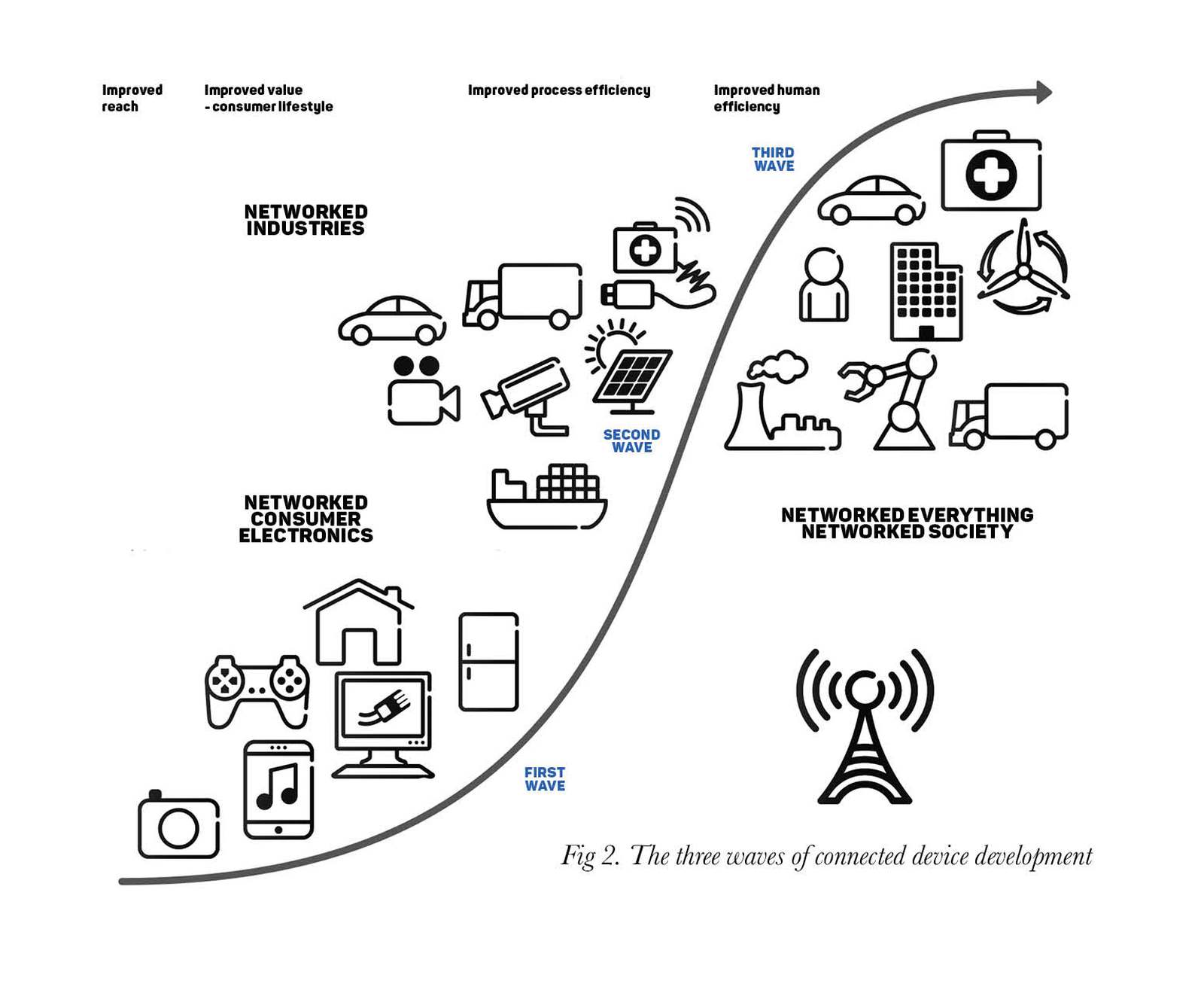
Understanding Narrowband
This article is from the CW Journal archive.
In 2010 Ericsson predicted there would be 50 billion connected devices by 2020. While that was optimistic, it highlighted the need for low-cost radio networks to provide the connectivity for numerous devices.
Connecting tens of billions of devices presents a number of challenges, many of which differ from the ones on which the mobile industry was focused in 2010. At that point, it was clear that consumers were taking to the idea of smartphones. The launch of the iPhone in 2007 had caught their imagination. When the App Store appeared a year later it highlighted the need for greater data capacity and download speeds. Operators started to gravitate towards unlimited data packages and put pressure on the industry to concentrate on evolving the 3GPP standards to meet that need.
Although 2010 was still in the very early days of the smartphone revolution – Symbian being the best-selling smartphone operating system at that time – and the consumer appetite for data was nascent, operators saw the writing on the wall and concentrated efforts on driving down the cost of smartphone data. That meant one thing to them – more data capacity in high population areas.
|
GET CW JOURNAL ARTICLES STRAIGHT TO YOUR INBOX Subscribe now |
While it was thought smartphones might contribute to around three billion of the connected devices in 2020, the bulk of the 50 billion was predicted to come from what we now term 'Internet of Things devices'. Some of these, such as connected cars, would require high data rates but the majority were envisaged to be far simpler devices, such as sensors, which would exist in everything from smart agriculture and smart cities to smart homes. They would be far more taciturn, in many cases sending their data to the cloud only a few times per day.
The majority of these devices could not be recharged daily like smartphones, but would have to rely on long-life batteries or energy harvesting. If they were as hungry as an iPhone 4, those 50 billion devices would consume around 50 TWh of energy each year, an amount equivalent to 150 per cent of the UK's current electricity generation. To allow these devices to run off batteries for years at a time, a fundamentally different design approach was needed at the radio level, compared to the way smartphone technology worked.
Another key difference is that many of these IoT devices were expected to be located in places with poor mobile coverage. Although many would be in smart cities, they might be deep within buildings or underground. A large proportion would also be outside these urban areas, with smart agriculture and environmental monitoring needing sensors where people weren't around, and therefore there was little existing cellular coverage. Economically, operators wanted a solution that didn't require new basestations.
a fundamentally different design approach was needed at the radio level
Equally important was the cost of connection. Consumers might be happy to pay £500 for a smartphone and £20 a month or more for their phone contract but the economics of deploying billions of sensors needed a different cost model. Here, the connectivity hardware had to cost under £5 and the data contract just a few pounds a year.
To keep data contracts low, operators would prefer not to install new basestations, but to upgrade what they already had. To meet the requirement of in-building and rural coverage, they needed a solution which provided a longer range so they didn't have to infill infrastructure. To encourage the growth of IoT devices, the radios also needed to be cheap and able to run on batteries for years. These were all requirements that ran in the opposite direction to those for more data capacity to support smartphones –which brings us to narrowband.

Narrowband is a word which is applied to communications systems where the frequency content of the transmission is generally within the coherence bandwidth of the frequency channel. Broadly, this means that transmission is confined to a very narrow range of frequencies which will all be affected by noise or fading. Because the energy is confined to a narrow frequency range, the received signal can be kept above the noise even at very low signal power.
Narrowband inherently limits the data rate, which plays to the physics of a trade-off between data rate and receiver sensitivity – as the data rate goes down, the receiver sensitivity improves. This gives narrowband an advantage in terms of overall link budget, which translates into longer range. It means basestations can be placed further apart, reducing the need for new infrastructure; where stations are already installed, it improves in-building signal penetration. A further advantage is that a narrowband radio design is generally relatively simple compared to broadband radios, which helps to reduce the silicon cost.
There's a fundamental reason why narrowband is preferred for devices that have transmit power and supply current limitations imposed through reliance on battery technology. It's a consequence of Shannon's theorem which shows that, for a given peak power, there is a ceiling on maximum data rate irrespective of transmit bandwidth. So, if your peak power is limited by battery current, there is little benefit in having a bandwidth much greater than a few kilohertz (see below Why Narrowband?).
Almost since the beginning of radio, systems have sought to minimise their bandwidth to get maximum range. HF and VHF radio systems, used in numerous private radio networks in industry and defence for monitoring and control, as well as in critical voice-based systems, such as Tetra (Terrestrial Trunked Radio) which is used by the emergency services, involve relatively low volumes of devices, rarely deploying more than a few million, generally in a specific vertical application. A consequence of this is that, apart from Tetra, none had promoted itself as a global, industry standard.
|
GET CW JOURNAL ARTICLES STRAIGHT TO YOUR INBOX Subscribe now |
Despite the excitement generated by Ericsson's prediction of 50 billion devices, 3GPP and network operators' attentions were dominated by the evolution of mobile broadband in the form of LTE. The industry was concentrating on faster data and higher capacities, and largely ignoring the requirements of the fledgling M2M or the future IoT markets.
on-ramp claims higher data rates and greater range than either sigfox or LoRa
This allowed a group of companies to develop proprietary narrowband solutions to fill the gap and to promote them as potential industry standards. Collectively, they described their technologies as low-power wide area networks (LPWANs) and this has come to signify any radio network targeting IoT applications.
The first to show global ambition was Sigfox, a French company founded in 2009 that developed an ultra-narrowband radio specification, operating in the sub-GHz industrial, scientific and medical (ISM) bands of 868 MHz in Europe and 902 MHz in the US. Based on low-cost, commercial radio chips which were widely used in toys and remote controls, the Sigfox protocol allowed up to 140 uplink messages to be sent from a device to a basestation each day, with a payload of 12 bytes. The receive sensitivity of around -130 dBm and maximum transmit powers of 100 mW (Europe) and 1W (US), gave a potential range of around 30km in rural and 5km in urban areas. Sigfox is fulfilling its aim to become a global IoT network provider and claims to have deployed coverage in 45 countries. Sigfox is essentially a one-way; and its short messages and lack of a proper reverse channel are limiting for applications and security.
Following closely on Sigfox's heels came LoRa (Long Range), operating in the same spectrum but with a wider bandwidth. LoRa can still be classed as narrowband radio, although its protocol adds spread spectrum to make it more robust against interference and to provide a flexible way to reduce bandwidth to improve link budget up to a similar level as Sigfox. This gives a higher data rate, allowing 242 bytes to be carried in each upload, with enhanced download rates.
Like Sigfox, LoRa also originated in France but from a startup called Cycleo which developed the underlying radio coding to address a variety of water metering applications. Founded in 2009, the company was acquired by Semtech in 2012 and 'Lora' was incorporated with its radio chips and restyled as LoRa. The new owner then formed the LoRa Alliance as an independent organisation to develop the higher-layer protocols and evangelise the standard.
LoRa is unusual in the way it is marketed. The LoRa Alliance has been working with existing network operators to deploy LoRa as part of their existing networks by adding low-cost access points and offering IoT users a managed service. However, it has also encouraged other companies, and even individuals, to buy and install their own gateways. As LoRa operates in an unlicensed ISM band, this led to the formation of the Things Network which encourages enthusiasts and companies to build an open IoT network. At the time of writing, there are over 4,500 independent LoRa gateways operating around the world, all connected to the Things Network.
The do-it-yourself capability also makes LoRa an interesting option for companies that want to deploy their own local IoT network. The LoRa Alliance claims to have deployed coverage in 49 countries as a result of partnering with 83 network operators.
There was a time when all radio systems were narrowband, in the sense that only the bandwidth needed to transmit the desired signal and get the longest possible range was used, given the limited transmit power available. Modern systems use a variety of 'broadband' techniques in the interests of multiple channel access, better spectrum co-existence, interference rejection, and so on; and also to exploit advanced signal processing, by using redundancy to correct reception errors, for example.
Whatever the technology, all systems are ultimately subject to Shannon's law which tells us the highest possible error-free information rate we can transmit through a channel, with a given bandwidth and channel noise, using a given signal power. Shannon tells us that wider channels can carry more bits – but, of course, they let more noise through. No assumptions are made about coding or modulation, with a mathematical upper bound showing what is possible – but not how to do it.
Many IoT systems have to carry information from low-power devices in hostile locations. The transmit power has to be low, to make the most of battery energy and to limit peak supply current. The path loss can be very high, so the received energy is small. In the NB-IoT system, for example, the maximum transmit power is 200 mW (23 dBm) and the system has to work with a coupling loss between device and base station of 164 dB, giving a received power of -141 dBm (which is about 80 attowatts).
Such systems operate in the 'low SNR' limit of Shannon's equation, where the maximum error-free information rate is given by 1.44(S/N), S being the average received power and N the noise density in watts per hertz. N is about -171 dBm for a very good receiver and the maximum possible error-free information rate is about 1.4 kbps. It turns out that this can be achieved with a channel bandwidth of about 3.75 kHz – there is little or no benefit from using wider channel bandwidths for power limited systems.
In America, another company had been thinking along similar lines. On-Ramp had developed LPWAN solutions which were being deployed in some metering applications. These differed slightly in combining narrowband with some extreme direct-sequence spread spectrum (DSSS) to achieve good sensitivity in the heavily used 2.4 GHz band, which requires a lot of interference rejection.
By taking this approach, On-Ramp claims higher data rates and greater range than either Sigfox or LoRa. Note that the US allows higher transmit power than most regions and at 2.4 GHz propagation loss will be nine times higher for equivalent antennas.
In 2015, On-Ramp changed its name to Ingenu and started rolling out its Machine Network. Unlike Sigfox and LoRa, Ingenu appears to be acting more as a dedicated metering and smart city network operator, rather than trying to be a general purpose IoT operator.
The specialised-network provider role has also served another player well – the UK-based Telensa in Cambridge.
Spun out of engineering consultancy Plextek in 2010, Telensa developed an ultra narrow band solution which has now become the most successful communication standard for street lighting in the world. Building on these deployments, the company is also expanding into other smart city applications, leveraging its installed street lighting networks.
Cyanconnode, another Cambridge-based company, has developed a self-healing, narrowband mesh network which is making inroads in smart metering. Both Cyanconnode and Telensa see themselves as serving vertical markets rather than being general-purpose IoT operators.
While Sigfox and Semtech were busy promoting themselves as alternatives to the traditional cellular networks, a third Cambridge-based startup Neul was taking narrowband radio in a different direction. The company was working on the premise that the whitespace spectrum that existed between TV channels could be freed-up for the new generation of devices in the Internet of Things. Neul developed demonstration chips and took the step of publishing its specification as Weightless, bringing on board a number of major companies to give it credibility as an open standard. The company found its aspirations to use whitespace thwarted by the elephantine pace of regulatory reform, but its technology was able to find another, and very important, outlet.
Bench Backhaul
Capacity from urban wifi such as the smartbench which has wifi with 4G backhaul and solar charging can provide useful links for IoT devices
While Sigfox, LoRa and the other LPWAN contenders were fighting among themselves to persuade the world they were the solution to IoT connectivity, 3GPP, the organisation which everyone had assumed would develop the appropriate standard, was doing a very good job of dropping the ball. What little work was taking place outside mainstream LTE development mainly took the form of talking shops for competing companies to gather support for their individual proposals, driven more by their intellectual property licensing aspirations than by the growing demands of the blossoming narrowband market.
In late 2014, as more operators signed agreements to support LoRa or Sigfox, it became apparent that the chatty competitors could lose hold of the IoT opportunity unless some positive actions were taken. On behalf of the network operators, the GSM Association (GSMA) lit the blue touch paper under the various committees and demanded to see a specification by early 2016.
The timing was opportune for Neul. With no sign of whitespace spectrum becoming available, it had started looking at migrating its technology into the licensed LTE spectrum for use by cellular operators.
NB-IoT
NB-IoT delivers up to 144 kbps – significantly higher than other LPWAN options and, being simpler technology, will have a lower component cost than LTE and draw less power from the battery. From the operator's point of view, NB-IoT can use re-farmed 200 kHz GSM channels, 180 kHz 'resource blocks' in a standard LTE channel, or guard bands at the edges of allocated mobile bands. NB-IoT does not support mobility. If an end terminal is moved, it needs to seek and re-join the network, which takes extra energy to run the receiver and transmitter during the process. It does not support TCP/IP and a proxy server, usually supplied by the operator, is needed to convert between NB-IoT data and standard internet traffic. What's more important is that it operates more like other LPWAN solutions than existing cellular options, allowing devices to sleep for most of their lives but with relatively low latency to wake and connect. Unlike other cellular devices, NB-IoT devices do not spend time and energy interrogating the cellular network. This makes it more suitable for static applications, rather than fast-moving mobile ones. The NB-IoT link budget is better than LoRa and Sigfox, giving it significantly better range than LTE and GPRS. Probably most important for its success is that it can be implemented as a software upgrade on many basestations, making it the lowest cost option for a network operator.
EC-GSM-IoT
Extended Coverage GSM for IoT (EC-GSM-IoT) is an extended version of GPRS. It will deliver up to 10 kbps, and the end terminal hardware can be based on 'obsolete' GSM silicon designs. It requires the terminal to transmit up to 2W to achieve the link budget, which is very difficult to achieve with small long-life primary batteries.
Bluetooth Long Range
Bluetooth Long Range, part of Bluetooth 5.x, offers long-range mode at a low data rate of 125 kbps (Bluetooth normally runs at 1 Mbps to 3 Mbps), and a range of up to two or three kilometres is claimed. Bluetooth is also standardising a mesh networking scheme, though it’s not clear whether this will be particularly low-power. Again, no direct-to-cloud offering is available for this technology, though its long range makes it probable that gateways will be developed. Bluetooth uses licence-exempt spectrum at 2.4 GHz.
LTE
LTE Cat-M1 up to 1 Mbps. At the base station it uses the same hardware as normal 4G voice and data services, so it's easily rolled out by the operator. Full mobility is supported, though the end terminal takes less power if it’s static, and Cat-M1 talks internet protocols (TCP/IP) directly. When data transmissions are small and can be sent infrequently, the end terminal can go to sleep and scheduled wake-ups occur when the end needs to receive anything. On the down-side, the silicon is quite complicated and will continue to cost tens of dollars for a while, and being based on the standard LTE air interface power consumption and cost are likely to be higher than NB-IoT. The subscription for LTE Cat-M1 is likely to be over $1 per month for each end terminal.
Sigfox
Sigfox, uses licence-exempt spectrum (around 868 MHz in Europe and 915 MHz in the USA). The target data rate is 50 bps, targeting 10 bytes to 20 bytes per day for each end terminal – which may sound crazy but is all that a simple sensor application needs. Transmission is primarily one-way (uplink) and the small message size and lack of an effective reverse channel are undesirable if the system is to be secure. The transmit power is exceedingly low at just a few milliwatts and the end terminal hardware costs around $3. Roll out of the service is quite good in Europe but still patchy in the USA. Subscriptions are likely to be around $1 per year, per end terminal.
Because Sigfox has the capacity only to deliver a few bytes per day from the base station to the end terminals and, as this is scheduled with other transmissions, it may take many minutes or even hours to send. There is no mobility and, like NB-IoT, a proxy server is needed between Sigfox data and standard internet traffic.
LoRa
LoRa technology (LoRa is the physical layer; LoRaWAN defines the MAC layer, or alternative higher layers) can be procured for a non-operator service. Silicon chips, modules and complete products are available for end terminals or base stations, and referenced open-source software is available. The Things Network is a crowd-sourced LoRa network users can join after buying a base station.
LoRaWAN
LoRaWAN, the LoRa Alliance implementation of LoRa, generally uses the same licence-exempt spectrum as Sigfox and delivers between 1 kbps and 22 kbps depending on various parameters. End-terminal hardware costs around $5 and typical use cases are from one message per day (of a few tens of bytes each) up to one message every five minutes. Two companies are rolling out networks in the USA and several operate in Europe. Like NB-IoT, there is no mobility and a proxy server is needed between LoRaWAN data and standard internet traffic. Part of the LoRaWAN protocol runs on the server to save costs at the base stations. Subscriptions are likely to be a few dollars per year, per end terminal.
During 2015, the various proposals within 3GPP were rationalised, leading to the publication, in March 2016, of the Narrowband-IoT (NB-IoT) specification. It was the first standard for radio to use the term narrowband as a branding, possibly because the 3GPP marketing machine had failed to match the pace of the engineering teams. Just in case, the GSMA started calling it an LPWAN the following year and even came up with a logo – which probably illustrates how desperate it was.
A significant factor in the evolution of NB-IoT was the LTE-M Sig, set up by Vodafone in early 2013 and includng Huawei, Ericsson, Nokia, u-blox, and a few others. Its objective was to develop a replacement for GSM for M2M but with a 20 dB better link budget, and offering between 10 and 15 years operation "on two AA alkaline batteries".
Lora deployed
Low power and low cost, for both the device and spectrum mean that LoRa was the right technology for a network of flood detecting sensors
Neul joined the Vodafone SIG, and combined its technology with similar proposals from Huawei – and, in the process, was acquired by the Chinese giant. This led to a partnership with Vodafone and u-blox to develop a low-cost solution which became an important contribution to the development of the standard.
Neul joined around August 2013 and the group reported in early 2014.
There were huge and bitter 'political' battles in its development but it led to a new work item in GSM Edge Radio Access Network (GERAN) out of which emerged two main proposals: EC-GSM and NB-IoT. This all ran parallel with the GSMA activity.
The jury is still out on which standard will succeed. Both Sigfox and LoRa have struggled to reach their connections targets – but that probably has less to do with their technologies than the fact that IoT deployments are complicated. The connection is just one part of the equation and deployments are probably being delayed by other parts of the chain.
NB-IoT has found strong support in China with around 20 different companies designing NB-IoT chips. Marketing statements claim that silicon prices could fall to the $1 mark by 2020. This may sound optimistic but there is nothing to suggest the $1 price point will not be breached as volumes reach the billions – NB-IoT’s advantage is that narrowband chips are relatively simple to produce.
The cost of data is also falling. IoT network aggregator 1nce has recently announced a "data for life" SIM, at the cost of €10 ($11.60) for 500MB and 2500 SMS messages spread over 10-years.
The major suppliers claim that over 100 million NB-IoT chips have already been shipped, with a prediction of 180 million by the end of 2018. How many of those will be actively sending data back to the cloud is another question, but volume helps.
The technologies mentioned so far are just the visible part of the narrowband iceberg. While the IoT community debates Sigfox, LoRa and NB-IoT, hundreds of other narrowband companies are busily deploying networks around the world. Some of the larger ones, like Telensa and Ingenu, have secured tens of millions in investment dollars and have seen their names rise above the parapet. Many others are quietly continuing to ship substantial numbers of narrowband products into vertical applications.
While much of the mobile world is obsessed with reaching higher data rates and streaming video, the narrowband industry is preparing to deploy connections by an order of magnitude that will never be achieved by smartphones or broadband radios.
|
GET CW JOURNAL ARTICLES STRAIGHT TO YOUR INBOX Subscribe now |
For the past thirty years Nick has been closely involved with short range wireless and communications, designing technology that helps to bring mobility to products, particularly in the areas of telematics, M2M, IoT, wearables, smart energy and mobile health. He is closely involved with the Bluetooth SIG, the Continua Alliance and other medical and wireless standards bodies. He is the author of 'The Essentials of Short Range Wireless' - a book attempting to explain the application of wireless technology to product developers.

Cambridge Consultants was started in 1960 to pioneer the delivery of independent design and development services in electronic, mechanical and product engineering: we are one of the founder companies of the high-technology Cambridge Phenomenon. Our history of world-class services is augmented by our development of intellectual property in areas including telecommunications, software, silicon, medical devices, machine learning, and by more than 20 successful spin-out ventures. Today Cambridge Consultants employs over 900 world-class engineers, scientists, project managers and technicians with offices in Cambridge UK, Boston, Seattle, San Francisco, Singapore and Tokyo; we provide the full range of services for excellent product design to a worldwide client base in the wireless, consumer, industrial, energy and medical markets. Tim Whittaker is a System Architect in the Wireless business unit, where he has taken the technical lead in projects using radio
standards like Bluetooth, ZigBee, DECT, and in the creation of specialist communications schemes for new applications, or to use new spectrum allocations.











